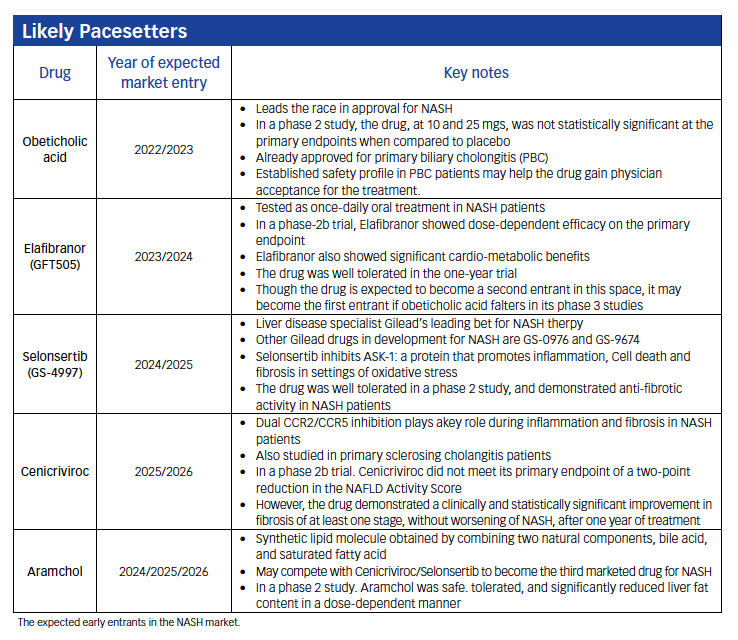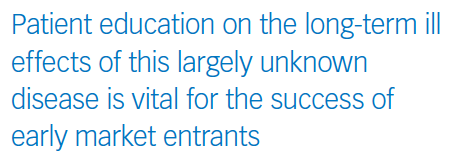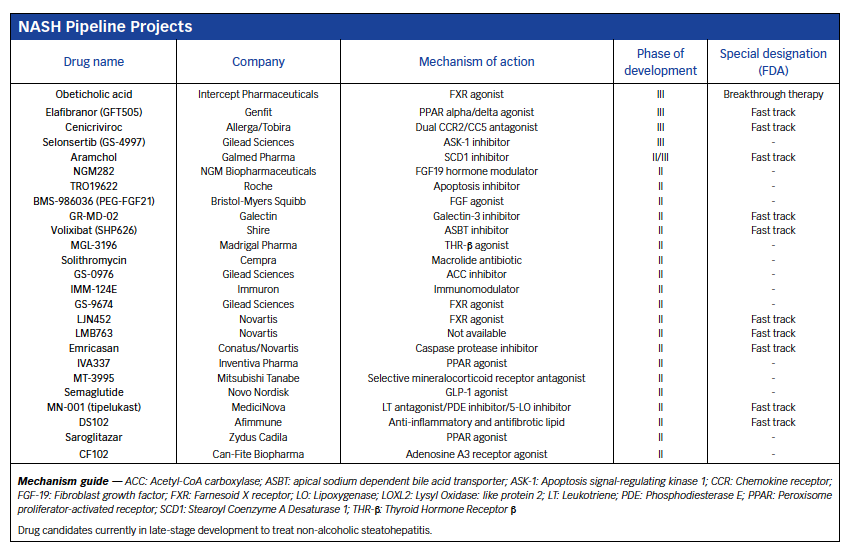Navigating the Untapped NASH Market
Pharmaceutical Executive
A potential rush of treatment options on the horizon for non-alcoholic steatohepatitis will require skillful maneuvering in this likely lucrative but uncharted therapeutic market.
With no approved medicine yet for the liver-destroying condition, a potential rush of options on the horizon will require skillful navigation of this likely lucrative but uncharted market terrain.
Non-alcoholic fatty liver disease (NAFLD) is the accumulation of triglycerides in the liver cells in the absence of any other specific liver disease. Non-alcoholic Steatohepatitis (NASH) is the severest form of NAFLD, categorized by a buildup of fat in the liver exceeding 5% of its weight.
NAFLD is a major potential threat to public health and a huge market access concern. Globally, one out of four is suffering from NAFLD, with the highest prevalence in the Middle East and South America, and the lowest in Africa.
The prevalence of NASH in the United States is between 3% to 5%, and it increases with the presence of metabolic disorders. NASH is expected to become the leading cause of liver transplantation by 2020 in the US.
Most NAFLD/NASH patients are asymptomatic or have nonspecific symptoms, such as fatigue. The well-known primary causes of NAFLD are obesity, type II diabetes, dyslipidaemia, and insulin resistance. However, diseases other than metabolic disorders also cause NAFLD. These include disorders of lipid metabolism (hypobetalipoproteinaemia, lipodystrophy), nutritional causes (total parenteral nutrition, starvation), medications (anti-HIV medications), and other causes (environmental toxicity). NASH can lead to other severe liver diseases such as fibrosis, cirrhosis, and hepatocellular carcinoma. NASH patients are also at an increased risk of cardiovascular diseases.
Though liver biopsy is the gold standard to diagnose and stage NASH, it has limitations when it comes to patient care. It is an invasive method, it comes at a high cost, and there are chances of sampling errors. There are also risks like bleeding, pain, perforation, infection, and even (on occasion) death. Several studies are currently underway to identify the biomarkers of NAFLD/NASH and non-invasive diagnostic techniques.
Treatment and management options
There is no approved treatment available for NAFLD/NASH. Lifestyle modification is the initial therapeutic option. Pharmacological treatment is considered for biopsy-proven NASH. Bariatric surgery is considered the last option to manage NASH. The current treatment and management options are as follows:
Lifestyle modification
Lifestyle modification (diet and regular exercise) is the main standard of care for NAFLD, and is the initial step to manage NASH.
Pharmacological therapy
- Anti-obesity drugs: Some studies on anti-obesity drugs have shown that they may improve NASH symptoms. In a small study on obese patients, Orlistat (inhibitor of fat absorption) caused weight loss and thereby improved NASH symptoms. However, long-term study data on the efficacy of these drugs on liver-related outcomes is not available, and some drugs may have serious central nervous system-related side-effects.
- Insulin-sensitizing agents: Several anti-diabetic drugs were studied for efficacy in NASH, considering insulin sensitivity is reduced in these patients. Though these drugs increase the insulin sensitivity, none of them were majorly beneficial in improving liver histology.
Lipid-lowering agents
- Statins: Statins reduce cholesterol biosynthesis, mainly in the liver, and modulate lipid metabolism through the inhibition of the enzyme HMG-CoA reductase. Statins are used to treat NAFLD as dyslipidemia frequently coexists with NAFLD/NASH, and there is an increased cardiovascular risk in these patients. However, there is limited real world data on statin efficacy in these patients.
- Omega-3 fatty acids: These drugs are assumed to have multiple beneficial effects in NAFLD patients, the important reason being the alteration in the hepatic gene expression, thereby increasing fatty acid oxidation and catabolism. They are also known to improve insulin sensitivity, are anti-inï¬ammatory, and reduce tumour necrosis factor-α levels, thus offering several potential therapeutic mechanisms. However, in a large population-based study, ethyl-eicosapentaenoic acid did not show any significant effects on NASH symptoms.
- Antioxidants: Oxidative stress is an important step in the pathogenesis of NASH and its progression. Vitamin E has antioxidant properties, and is vastly studied as a potential treatment for NASH. Though Vitamin E demonstrated improvement in steatosis in a clinical study, it failed to improve the necro-inflammatory activity or alanine aminotransferase levels.
Bariatric surgery
Bariatric surgery causes massive weight loss and remarkable histological improvement, including partial reversal of cirrhosis. In morbidly obese patients, bariatric surgery improves the histology, including resolution of NASH in 75% of cases and reduction of fibrosis in 34% of cases after a long follow-up. Massive weight loss associated with the surgery reduces pro-inflammatory mediators, thereby improving the hepatic insulin resistance and inhibiting the hepatic inflammation.
Challenges for the early market entrants
Drug pricing
Payers may be reluctant to cover highly-priced NASH drugs, since the medicine has to be taken for a longer duration. So, the price fixed by the early entrants will play a major role in market success. Payers may also be reluctant to cover potentially expensive drugs, in part because lifestyle modification is often the first-line treatment for NASH.
Physician acceptance
Since lifestyle modification is the initial step to manage NASH, physicians might be reluctant to prescribe the drugs for the disorder. Hence, targeting and educating physicians will be crucial for the successful
Likely NASH pacesetters; click to enlarge

market access of products in this space.
Patients’ unwillingness to undergo diagnosis
Although the prevalence of NASH and NAFLD are high, the diagnosis rate is low since liver biopsy is the gold standard to identify the disease. Since liver biopsy is a painful procedure, some patients may opt out of diagnosis, leading to a low diagnosis rate. Hence, patient education on the long-term ill effects of this largely unknown disease is vital for the success of early market entrants.
Diagnosis, staging of NASH
Liver biopsy is the only method available to diagnose and stage NASH. However, this is an expensive and invasive procedure, causing patient discomfort and potential side effects, which can even lead to death. Non-invasive methods are under development. Discovery of easily identifiable biomarkers, as in patients with diabetes (serum/urine glucose, HbA1c tests), will help monitor/stage the disease, as well as in dose adjustment of the drug thereafter.
Future competition

Many competitors are vying to garner a major share of the untapped NASH market. Considering the unmet needs in this area, regulators are also promoting the development of promising drugs by providing special designations. A thorough understanding of the strengths and weaknesses of the late-stage product pipeline or next entrants, and their impact on potential sales will help in strategizing for the sustained commercial success of NASH treatments.
Combination therapy
There are a variety of drugs with different mechanism of actions in late-stage clinical trials to treat NASH (see table below). Since NASH is a multifactorial disease, it is most likely that a multifaceted combination therapy will be needed to successfully and effectively treat the condition. Hence, the collaboration/acquisition of other effective drugs in the pipeline, and testing combination therapies earlier could be a significant strategy for early entrants.
Click to enlarge

Prime opportunity
The prevalence of metabolic disorders such as NASH is increasing at an alarming rate, and the untapped NASH market, worth billions, is predicted to be the next big market to emerge in this segment.
Several big pharma companies, including Novartis, Gilead, and Allergan, as well as smaller players in the space, such as Intercept and Genfit, are betting big on NASH therapy, considering the large-scale unmet needs and potential financial benefits achievable by being the first entrant in the market.
Some important questions for potential new product entrants are:
- What should be the optimal price for the first drug to convince payers, and make it a blockbuster as well?
- How can physician acceptance be increased?
- How can the diagnosis rate be increased to get more patients to treat?
- Are collaborations necessary to develop combination products?
The first companies to usher in new treatments to the NASH market should find answers to these questions, which will eventually help them grab a major portion of the potential market. Different market access solutions, such as forecasting, pricing strategies, business development/licensing evaluation, and go-to market strategies, would help the early entrants achieve easier access, and increase the potential of their products. Competent partners who have the industry know-how and relevant expertise in this arena can help drugmakers strategize better and identify potential avenues to reap gains in this increasingly critical market.
Jayachandra Reddy is a Senior Director and Rishit Thakkar a Senior Project Manager, both with phamax

Trump: 'Major Tariff' on Pharmaceuticals Coming Soon
Published: April 9th 2025 | Updated: April 9th 2025“We’re going to tariff our pharmaceuticals, and once we do that, they are going to come rushing back into our country," President Donald J. Trump said during a Tuesday night dinner in Washington.
Trump: 'Major Tariff' on Pharmaceuticals Coming Soon
Published: April 9th 2025 | Updated: April 9th 2025“We’re going to tariff our pharmaceuticals, and once we do that, they are going to come rushing back into our country," President Donald J. Trump said during a Tuesday night dinner in Washington.
2 Commerce Drive
Cranbury, NJ 08512
All rights reserved.